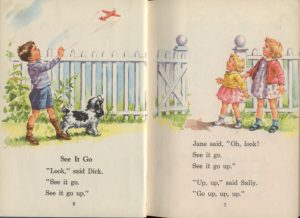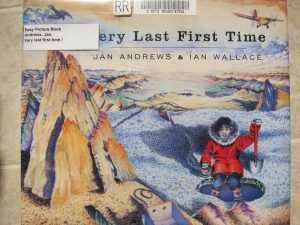 I was struck by the juxtaposition of the reading Ernestine Hayes shared with us and the lesson presented by Kathy. Ernestine spoke about reading Dick & Jane books at school, books filled with blonde children in new clothing with two parents and a dog named Spot. Tlingit culture was not represented in any of the stories Ernestine read at school. Ernestine’s story was painful, but so important to hear. Kathy reminded that representation in a lesson is critical, along with respect for all children (and their families) in each classroom.
I was struck by the juxtaposition of the reading Ernestine Hayes shared with us and the lesson presented by Kathy. Ernestine spoke about reading Dick & Jane books at school, books filled with blonde children in new clothing with two parents and a dog named Spot. Tlingit culture was not represented in any of the stories Ernestine read at school. Ernestine’s story was painful, but so important to hear. Kathy reminded that representation in a lesson is critical, along with respect for all children (and their families) in each classroom.
Fortunately, we have many culturally relevant resources available AND we are being taught to use them. We are encouraged to work with local communities to enrich our classrooms. We have the opportunity improve literacy and introduce even other complex lessons … and Kathy reminded us we can even use picture books!
 I read a few different picture books and thought about how a series of stories about different regions and cultures in Alaska (Yup’ik, Athabascan, Inupiaq) could be used in a lesson The stories I read were: Berry Magic, by Teri Sloat and Betty Huffman; Anna’s Athabaskan Summer by Arnold Griese; Very Last First Time by Jan Andrews. In a lesson with social studies lesson with secondary students, the class could begin to learn about the different geography, culture, and subsistence practices in each region. It could be integrated into a science lesson about how the environment and availability of certain resources impact differences in tools, technology and trade. Reading the different stories could also be used in a language arts lesson to look at how to construct a story about your own culture. I would be interested to see students write/tell stories about how they gather food today compared with how their grandparents might have collected food, what are the similarities and differences?
I read a few different picture books and thought about how a series of stories about different regions and cultures in Alaska (Yup’ik, Athabascan, Inupiaq) could be used in a lesson The stories I read were: Berry Magic, by Teri Sloat and Betty Huffman; Anna’s Athabaskan Summer by Arnold Griese; Very Last First Time by Jan Andrews. In a lesson with social studies lesson with secondary students, the class could begin to learn about the different geography, culture, and subsistence practices in each region. It could be integrated into a science lesson about how the environment and availability of certain resources impact differences in tools, technology and trade. Reading the different stories could also be used in a language arts lesson to look at how to construct a story about your own culture. I would be interested to see students write/tell stories about how they gather food today compared with how their grandparents might have collected food, what are the similarities and differences?
I hadn’t thought of combining several stories into a series, but that is a great idea. I think that could, and would, make your class more open to students who struggle with reading for content. If one picture book is great, then more is better (after adequate evaluation).